In order to get ahead financially, you must spend less than you earn…aka save money. If you don’t have savings, its time to get one. If you are saving, that is awesome. You can take today’s challenge to improve your system (if possible).
Saving money is crucial because living from paycheck to paycheck is not a peaceful or wise way to live. Unforeseen expenses will always come up. Having savings will give you peace of mind, as well as help, keep you out of debt when emergencies arise.
Many people work their entire lives, paying taxes, interest, payments, etc. but forget to pay themselves. At the end of their career, they are left with less than they had imagined and are forced to continue working, sell their homes, etc. Starting right now to save will get you on the path to gain financial freedom.
Some may wonder if they should start a saving despite being in debt. The answer is almost always a yes. So…
Challenge #5: Even if you have debt, determine right now the amount of money (percentage or dollar amount) you can set aside with each paycheck. Next, determine where you can put it and won’t be tempted to spend it. Make a commitment that as soon as you are paid you will set aside a certain amount (say 1%-10% or perhaps a certain dollar amount like $10.00- or $200.00) somewhere which will be your retirement fund and/or only used for emergencies.
If you will do this each time you get paid, you will be amazed at how fast your savings will grow. If you (and those who have access to the account) have good-savings-discipline, you could just keep the savings in a regular savings account.
But, if you or someone who has access to your accounts have difficulty not spending savings, here are a few ideas of what you can do:
- You can you set up a free checking account at a different bank or credit union and have the funds automatically sent to the account each month (which is usually a free service). So as soon as your check comes in, your regular credit union or bank immediately transfers the money over to the other one.
- You can put the money into a depository safe (like this one) in your home and have a trusted person keep the keys so you can’t get in it. The money will go in but will not easily be retrieved.
- Another idea is, to set up an investment insurance policy and then add extra money into it through automatic payments. Not only is it a life insurance policy (whole life or IUL) but the extra money you put in 5-8% interest every year. You can access the money by calling and a check is sent within a few days, but we are required to pay it back. IUL policies or whole life can be a good forced savings vehicle.
- If you use mobile and online banking, some banks and credit unions can hide your savings account from view. By having your savings ‘out of sight out of mind’ you or anyone else who has access to the bank account will be less tempted to spend it.
- Another type of savings accounts your bank may have could be called a ‘Goal Setter’s’ savings account. With these types of accounts, you can add money easily but can’t touch it unless you go to the bank and fill out paperwork to get it. This type of account was designed for those who have or who have spouses who have difficulty saving money. Filling out paperwork is definitely a deterrent to spending and is worth looking into if you or a spouse has trouble saving.
However much you decide to save each paycheck and wherever you decide to put it, just make it as simple, automatic, and as non-tempting as possible.
If you stay consistent with this you will be surprised at how much you will save over the months, years, and decades.
Remember, it is not how much you make, it is how much you keep. So please make sure not to skip this step!
Other Posts:
Step 1 of the Financial Fitness Bootcamp Course
Step 2 of the Financial Fitness Bootcamp Course
Step 3 of the Financial Fitness Bootcamp Course
Step 4 of the Financial Fitness Bootcamp Course

For other ‘rich living tips’ please subscribe, like me on Facebook, and follow me on Pinterest and Instagram.

SUBSCRIBE FOR OUR EMAILS

